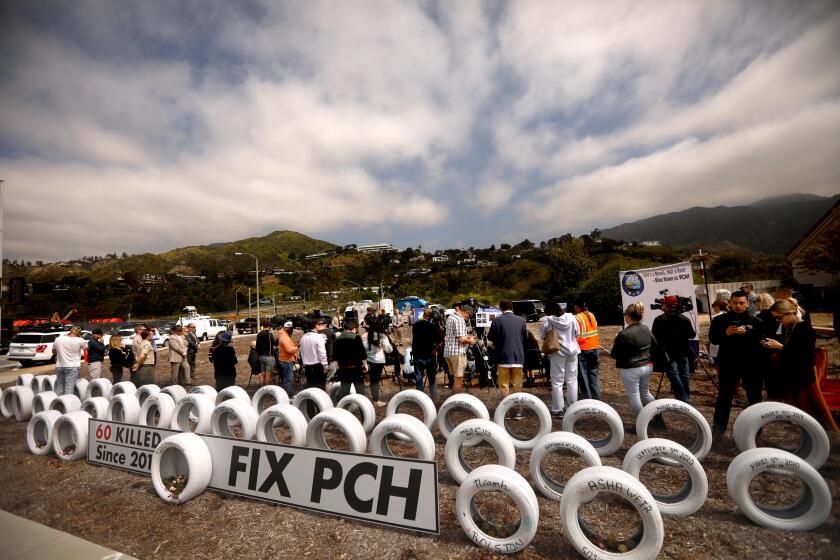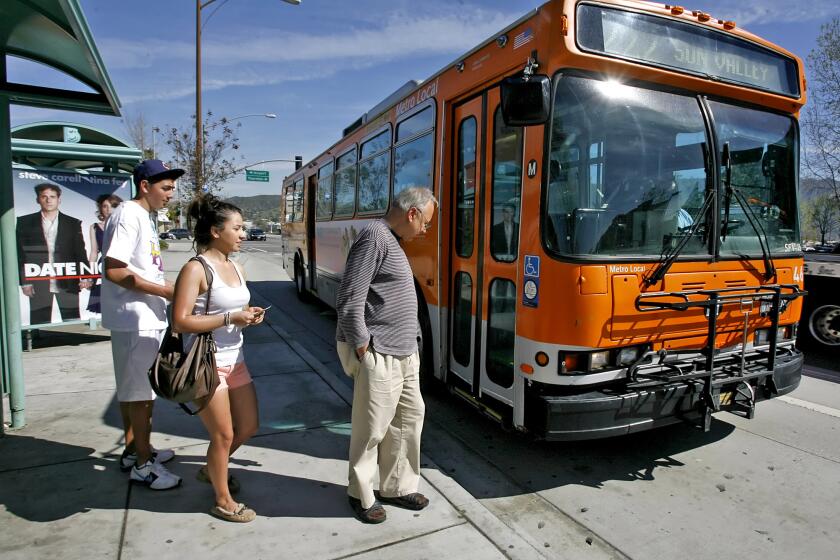More Time Going Nowhere
Commuters streaming into Orange County from Los Angeles, San Bernardino and Riverside counties will see the daily rush hour swell from four to seven hours over the next two decades as demand for new employees outstrips the county’s ability to house them, according to a new regional transportation study.
Describing the slow-speed corollary to a revving economy, analysts predict this growing crunch will occur throughout the rugged Chino Hills area--the main gateway to Orange County from points east.
This territory, dubbed the “Four Corners” area because the borders of all four counties converge there, will see traffic volumes double by 2020 and speeds slow from 25 mph to about 10 mph along notorious stretches of the Riverside and Orange freeways.
The report, which is being reviewed by the Orange County Transportation Authority and the Southern California Assn. of Governments, attributes much of this increased congestion to people who will land jobs in Orange County and Los Angeles but live in Riverside and San Bernardino counties.
In response, analysts have suggested 55 improvements totaling $1.3 billion, including new roads, toll lanes and express bus routes and expanded light-rail service.
However, the report’s authors concede that in some cases, particularly along the jammed Riverside Freeway, these fixes are “woefully inadequate” in dealing with a projected increase of a quarter million commuters a day.
In other instances, legal battles and disagreements between counties over the proper solutions might doom the report’s recommendations. Ultimately, analysts say, policymakers must address the lopsided commuting patterns by encouraging new employment in the Inland Empire and by increasing affordable housing in Orange and Los Angeles counties.
Planners chose to scrutinize the Four Corners area because it is the main corridor between the Inland Empire and developed areas of Orange and Los Angeles counties.
“It’s an area that’s been a problem for many years,” said James G. Douglas, project manager for the Four Corners study. “Transportation agencies have been struggling for years to find a solution to problems there.”
Word that daily commutes into Orange County would increase by more than 47% during peak hours comes as no surprise to some.
‘I’ve been driving through that area for five years, and it’s only gotten worse,” said Debbie Litzinger, a Riverside County resident who commutes daily to Ricoh Electronics Inc. in Tustin. “I feel myself getting angrier and angrier every day. I feel like I’ve spent half my life on the 91 Freeway.”
The report, prepared by Parsons Brinckerhoff Quade & Douglas Inc. of Orange, concludes that previous attempts to reduce congestion in the area, including construction of the Eastern Transportation Corridor toll road and the installation of restricted carpool lanes on the Riverside, Orange and Pomona freeways, have all failed to ease congestion.
While the study fails to offer any final solutions to the congestion, some policymakers say it adds fuel to a controversial proposal to build a new transportation route between Orange and Riverside counties.
“I’m absolutely convinced that we need an alternative freeway or toll road,” said OCTA Director and Orange County Supervisor Todd Spitzer. “North Orange County and the Inland Empire are really on the precipice of a transportation crisis.”
Already, a committee of OCTA directors has scheduled talks with their counterparts in Riverside County to discuss such a possibility. The discussions are part of Riverside’s continuing overhaul of its county plan. County officials have already begun a long-range study examining proposals for four new transportation corridors--two within the county and two more connecting the Moreno Valley to San Bernardino County and Riverside County to Orange County.
The Four Corners report does not examine the possibility of constructing a new transportation corridor, but it does say there are numerous obstacles to upgrading the existing Four Corners transportation system. They include steep, hilly terrain, legal battles surrounding the Riverside Freeway and its toll lane franchise and efforts to create a large wildlife preserve in the area.
Among its 55 recommendations, the Four Corners report suggests increasing existing highway capacity by adding lanes (both free and toll), extending light-rail service from Fullerton to the city of Industry, expanding freeway tow truck patrols, encouraging bus ridership along expanded express routes, and the construction of a $180-million road through Tonner Canyon, between the Chino Hills Parkway and the Orange Freeway in San Bernardino and Los Angeles counties.
In Orange County, the Four Corners territory includes the Orange and Riverside freeways, Imperial Highway and Carbon Canyon Road. The report predicts that traffic on sections of the westbound Riverside Freeway, which moves about 25 mph during rush hour, will slow to less than 10 mph by 2020, and that travel times from Diamond Bar to Santa Ana, Chino to Costa Mesa and Corona to Anaheim will increase more than 47% during peak hours. For example, a morning commute from Corona to Anaheim could nearly double to 97 minutes.
The study’s most expensive recommendations focus on the Orange and Riverside freeways. It recommends a $250-million overhaul of the chaotic, mile-long interchange between the Orange and Pomona freeways in Diamond Bar. It also suggests a $307-million addition of two lanes, possibly toll lanes, to the 15-mile stretch of the Orange Freeway between the Garden Grove and Pomona freeways.
The study also calls for the development of express bus service along the Orange Freeway, connecting Orange County to the city of Industry Metrolink station in Los Angeles County. For the Riverside Freeway, the report recommends adding two toll lanes between the Eastern Toll Road and the Corona Expressway, a chronic bottleneck. It also calls for connecting those roadways’ toll lanes and extending toll lanes east to the 15 Freeway--for a estimated total of $250 million.
The report notes, however, that legal issues surrounding the Riverside Freeway toll franchise complicate these improvements, and Riverside officials flatly object to extending the toll lanes into Riverside County. “That’s a nonstarter for us,” said Riverside County Transportation Commission spokesman John Standiford.
On the topic of jobs in Orange County, the study says that between 1994 and 2020, Orange County’s population is projected to increase 25%, while employment would grow by more than 70%.
Douglas said there is only so much that can be done to improve transportation if Riverside County continues to grow as a bedroom community and jobs keep growing elsewhere. “Eventually, you get to a point where the transportation system can’t handle it anymore,” Douglas said. “Eventually people will reach the point where they can’t endure the commute anymore and they just won’t make the commute for jobs here.”
More to Read
Start your day right
Sign up for Essential California for news, features and recommendations from the L.A. Times and beyond in your inbox six days a week.
You may occasionally receive promotional content from the Los Angeles Times.







